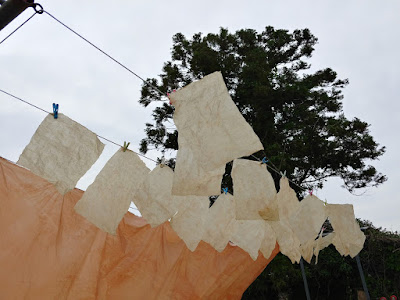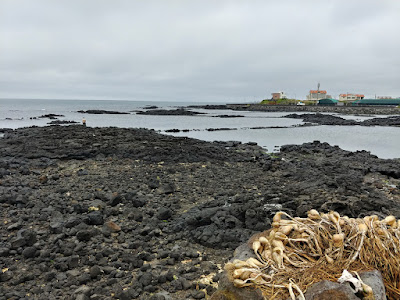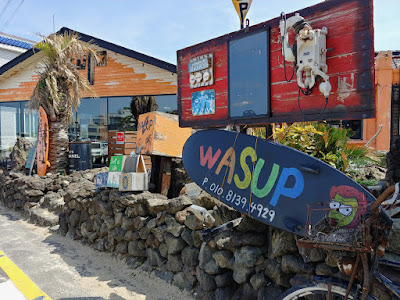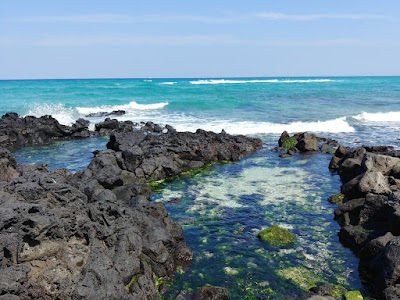This is supposed to be my down time but I felt like I had to at least do one post while I am here, my own compulsion. I landed in Jeju on Monday morning and got very confused trying to find the best bus so I had to wait for a while but it was all fine, no real schedule. I arrived on a cloudy and rainy day.
Yang Soonja, a master persimmon dyer that I have written about in my book and first met in 2009, welcomed me back to her home, which is a real honor because she the way she takes care of me is almost as if she knows this would put my mom at ease. Here is the glass house across from her home, which is so comfortable and quiet aside from the birdsong at dawn. This is where she can hang her dyed fabric to get more sun but be protected from other elements.
At Mongsengee, her business, I was so glad to see that she had moved to a better suited location than when I saw her last in 2014. So much has changed then, and I was relieved that she is in a better place than when she was forced out of a location that suited her so well. But this space works now that she is getting older and doesn't need massive fields to bake her fabric in the sun. This is gorgeous dyed silk that she is turning into a durumagi, a traditional overcoat in Korean clothing.
I felt badly just descending with only a few days notice but on the day that I did a lot of outdoor work for her, she was able to finally get a few quiet moments to work on this piece due very soon to a client.
She always takes morning walks and I was able to join her for two but the third day it rained hard so we had to skip it.
Both days we took different routes but passed some similar landmarks.
She lives in Jeoji artist village, where there are tons of museums and creative folks, though I only saw the outsides because she had a packed schedule.
One evening, we stopped by a guest house near the water and her old friend insisted that she feed us dinner. This woman (center) was also in fashion and lived in Japan for many years, raising her three children with the work of her hands, and now running this guest house. They have known each other for many years and Ms. Yang visits her when she wants to feel like she's being fed by mom. I get that instinct.
Wednesday was Buddha's birthday, a national holiday. Since no employees were coming to work, we took our time getting there and then worked all day. First we had to unpin and remove all the fabric that had been dyed the previous day and left to receive sunlight, necessary to bring out its color.
Then we had to soak all of the fabric in water and drain it of water.
This is like a drain basket and eventually all sides have dripping fabric hanging over them.
The fabric has to be shaken out, tugged upon, and pinned down. We pinned into the ground but not taut, as the fabric shrinks as it dries. Over time, we had to go and unpin and repin so it wouldn't tear or pull out the awls.
Ms. Yang is very good about making work easier for her, using a cart to transport water laden fabric.
This is fabric that was already pinned down flat once, so they need to be hung on lines to receive sun while the more newly dyed fabric goes onto the lawn. Yes, plenty of bird poop, plenty of hand washing.
During the sweaty labor, a few women arrived with children asking where the pizza experience was. Apparently in the building directly across from Mongsengee, mothers were taking their children to make pizza. Ms. Yang said she never has time to do this as she is working, but we treated ourselves to making a cheese pizza alongside all the wee ones.
I don't know if the pizza oven lives here or if the people running the activity brought it over, but it was great to have one that baked it so quickly.
Ta da! We had already had fast food the previous day because we had gone into Jeju City for some errands (Mongsengee is in Hallim, further to the northwest) and I think me being from New York stirred homesickness in Ms. Yang as she spent at least 15 years in Manhattan, studying fashion, working, and raising her kids. She had mentioned pizza and bagels so it was funny to have pizza appear the next day.
I wasn't joking when I said this was otherwise solely a thing that little kids and their moms were doing.
On my first or second day, Ms. Yang noticed huge weeds that had sprouted almost overnight, and was busy pulling them. When I tried to help, I promptly ended up on my ass, so it was not a good task for me.
The soil here is rich with her spent persimmons. For food waste, all I had to do was dig a hole with a shovel and dump in the trash before covering it up. Nice loose soil, and there was even a tomato plant that apparently started growing on its own after she had thrown away some tomatoes in that patch.
Of course I wanted to dye hanji, mostly in preparation for a Jeong project to support organizations that support vulnerable and marginalized communities back in the US. It's in response to the Atlanta murders but I have to admit that I feel really far away from all of it. This distance has been really helpful in giving me a respite from certain types of violence and fear, but I'll still be making and donating artwork for the deluxe portfolio.
After getting the paper wet (I had already cut it down smaller to make it easier to handle), we squeezed out as much water as possible before layering paper with persimmon juice.
This trip has been so instructive in correcting glaring errors as well as subtle ones. This one I only realized during the natural dye symposium a few weeks ago, that I have been spreading massive misinformation about Korean persimmon dyeing (gammul is the dye, as gam is persimmon and mul is technically water but here we're meaning dye or juice): it's not fermented! Facepalm. I mean, a giant DUH, for so many years I overlooked this really important fact. Japanese persimmon dye is fermented for about three years but then has to be boiled. Korean is fresh from the mashed green fruit, strained, and then refrigerated. No boiling necessary.
That explains why the color doesn't appear right away like with Japanese versions. This is the hard part, picking up each sheet individually without tearing it, and spreading it out on the grass on a very windy afternoon. We somehow didn't lose any sheets (I think) and the juice helped basically glue the paper to the grass underneath.
It's vital that the dyed stuff gets sun right away as it dries. After it is totally dry, then you can do successive rounds of getting it wet/damp again and exposing it to sun for the color to really appear.
Once I felt the sheets were coated and stiff enough to withstand wind, I pinned them to the line to get more dry. I had to pull of lots of grass and dirt, but some will stay embedded. At the end of the day, we took everything off the lines and off the lawn because rain was forecast for the evening into the next day. We hung the paper and one batch of the fabric in the glass house. As Ms. Yang said, even in the rain there is sun.
On my second day, I got a BIG treat, which was to visit Brenda at her beautiful Jeju home! We walked from the main road and you can see the lovely Korean tiled roof from afar.
I had read her book the day before so I felt really immersed in this story, which is incredibly inspiring. It seems unreal, really, like something you can only read about in a book, but it's very real. You can see videos here.
This little building was a cow shed but now is a writing space. The whole place inside both structures is so peaceful and airy, and filled with so much love and intention that you feel like you can sink into yourself safely and comfortably. Brenda prepared the outdoor parasol for us to picnic outside. Ms. Yang should have left earlier to get to work but was kind enough to let me ramble on and on because I hadn't seen Brenda since 2014 in Jeju.
She looked so content and present, and has given me an enormous amount of food for thought when it comes to how to move forward in the world with intention and care.
Like her homemade yogurt served indoors! And of course the house is papered in hanji, which is a key touch, for many reasons. Not only aesthetic, but health-wise, to the lungs and eyes and mind and heart.
Brenda took me out afterwards for pretty refreshments overlooking the sea while I unloaded a lot of my baggage. The idea that she could move to Korea later in life and become a citizen, build a house and life for herself and her husband, and continue to do her work and find meaning here was revelatory.
I mean, this is the view when you just go to tea? In many places on this island? So many things have already fallen away.
She offered her art studio as a place to stay near the water and a bus line, so I took her up and she of course treated me to a bountiful lunch before taking me to get groceries and showing me the area. As an artist and writer herself, she was really clear that this was about me getting a retreat, so she has made lots of space for me while also taking excellent care of me. As I wasn't able to get my laundry done at Mrs. Yang's house because of the rain schedule, Brenda whisked my dirty clothes away! In what feels like Native American culture, I feel truly blessed to have these "aunties" watching out for me.
After I was left to my own devices, I got settled inside before venturing out on a grey, blustery, cool afternoon. The wind here is NO JOKE. I had to tighten my cap and pin it to my hair, and forgot until I was almost back that I had a hood on my jacket. On the winding road directly on the coast, there were murals on many of the barriers.
This is one area where haenyeo harvest seafood, and Brenda has been instrumental in bringing more attention to these women through her book and advocacy. She has seen them get more international attention, including UNESCO designation.
Food from the sea is not the only thing that is harvested, and all along the road there were shallots, garlic, and so on drying on the barriers, stones, and roadsides.
Even though it had rained a bunch, they are everywhere.
At various points, the barriers open onto steps that descend to the sea.
Some of the barriers are made of stone walls, very particular to Jeju.
Wetsuits are hanging here as this is an area where people can learn to dive like haenyeo.
This is near a resort area but regardless, things grow abundantly here, whether weeds or flowers.
At the haenyeo school, I think, and all of the statues I see in this area are of women, who are incredibly powerful because they historically have provided so much of the livelihood for their families and communities (plus so many men had been killed either at sea, at war, or through massacre).
Buoys taped with reflective tape line some of these walls, as there aren't lights on the road at night.
This morning I had a slow start and though I needed to do annoying computer work, I ditched it to head to a nearby beach. I'm so glad I did. I really needed it.
The usual beachside places to eat/drink.
While plastic trash is easy to pick up to throw away, when I see things like living marine life ON plastic, I wonder what we've wrought. Nothing to be proud of, and yet these little creatures persist.
I started out thinking I wouldn't take off my shoes or go into the water.
But there's no way to resist that temptation, and watching the children play in the sand reminded me that these are really human instincts, good ones to follow.
Afterwards, I was torn about where/what to eat and finally in my exhaustion ended up very close to my digs. I didn't think at first that I could eat the entire fish myself but then I absolutely did, while the woman who cooked my food chatted with me the whole time. I was the only one there as it was past lunchtime and I had woken her up from a nap when I greeted her to ask if it was still okay to sit down to eat.
This is where I'm writing from now, at Cafe Maggie or Maggie Chueok (memory), recommended by Brenda. I could stay forever but I think a nap is calling. Just a few more days of healing to go!





















































3 comments:
the healing sea and sky and, yes, wind
Such an amazing adventure you’re having. So thrilled for you Aimee. Thanks for sharing all this.
love your facepalm story about korean persimmon not being fermented. Fascinating!
Post a Comment